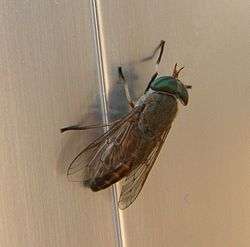Tabanus nigrovittatus
| Tabanus nigrovittatus | |
|---|---|
 | |
| Greenhead Horse-Fly | |
| Scientific classification | |
| Kingdom: | Animalia |
| Phylum: | Arthropoda |
| Class: | Insecta |
| Order: | Diptera |
| Family: | Tabanidae |
| Genus: | Tabanus |
| Species: | T. nigrovittatus |
| Binomial name | |
| Tabanus nigrovittatus Macquart, 1847 | |
| Synonyms | |
|
Tabanus allynii Marten, 1883 | |
Tabanus nigrovittatus, also known as the greenhead horse fly, salt marsh greenhead, or simply the greenhead fly, greenhead or greenfly, is a species of biting horse-fly commonly found around coastal marshes of the Eastern United States. The biting females are a considerable pest to both humans and animals while they seek a source of blood protein to produce additional eggs.[1] Females live for three to four weeks and may lay about 100 to 200 eggs per blood meal.[2]
Affected coastal communities install black box traps in marsh areas to reduce and control T. nigrovittatus populations.[3]
See also
| Wikimedia Commons has media related to Tabanus nigrovittatus. |
References
- ↑ Hansens, Elton; Race, Stuart. "The Greenhead and You". Rutgers Equine Science Center. Rutgers. Retrieved 6 July 2017.
- ↑ Stubbs, A. & Drake, M. (2001). British Soldierflies and their Allies.
- ↑ Graves, Annie. "Greenhead Flies | What are Greenheads?". Yankee Magazine. New England Network. Retrieved 6 July 2017.
This article is issued from
Wikipedia.
The text is licensed under Creative Commons - Attribution - Sharealike.
Additional terms may apply for the media files.